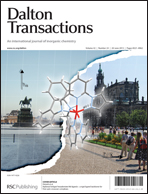High-throughput microwave-assisted discovery of new metal phosphonates†
Abstract
A systematic study was carried out to investigate the influence of linker geometry, metal ionic radius as well as the nature of the counter ions on the structure formation of metal tetraphosphonates. Two tetraphosphonic acids p- and m-(H2O3PCH2)2N-CH2-C6H4-CH2-N(CH2PO3H2)2, six metal ions (Ca2+, Mn2+, Co2+, Ni2+, Zn2+, and Cd2+) and two different counter ions (Cl− and NO3−) were employed using high throughput methods. Microwave (MW)-assisted heating led to the discovery of ten new metal-


 Please wait while we load your content...
Please wait while we load your content...